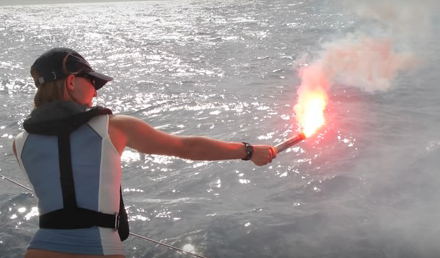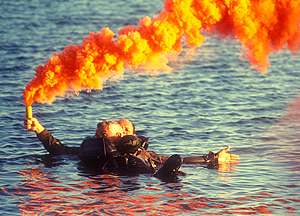Marine Flares and Distress Signals
|
Marine flares and distress smoke signals are pyrotechnical devices and are very sensitive to moisture.
In order to guarantee proper operation in an emergency case, the signals should be stored carefully
in a sealed bag on a dry, cool, easy accessible place on board.
But also properly stored, these signals have a limited lifetime; usually not more than a couple of years.
A careful visual examination of the distress signals is part of the regular safety inspection on a seaworthy yacht.
It is the captain's responsibility to instruct his crew on all safety issues and explain
the proper usage of the emergency flares and smoke signals that are available on board.
Each crew member should be aware of where to find the emergency signals and how to use them.
|
Warning:
Pyrotechnics devices have a very hot flame, and the slag (molten discharge) can cause burns and
may ignite material that burns easily.
Projected devices, such as pistol launched and hand-held parachute flares but also meteor flares,
have many of the same characteristics of a firearm and must be handled with the same caution
and respect.
|
 |
Red and orange alert signals should be used exclusively in a real and imminent distress situation.
White signals may be used for non-distress situations and are intended to caution approaching
vessels of your position or to illuminate an area at night.
Marine flares and smoke signals come in different forms and with a variety of operating principles.
As such, it is essential to read and understand the operating instructions printed on the
individual devices, before using them.
|
 |
Here is an overview of some popular types of visual alert and homing signals
that may be found on seagoing yachts:
- hand-held flares (day and night signal)
- rocket (aerial) flares (day and night signal)
- hand-held smoke signals (day signal)
- floating smoke signals (day signal)
- pyrotechnic signal kits
BY LAW. IT IS ILLEGAL TO IGNITE/FIRE DISTRESS SIGNALS IN A NON-DISTRESS SITUATION!
|
Classification
Visual distress signals may be divided in two basic categories:
Locate signals are usually hand-held flares that will burn for one to two minutes.
Hand-held signal flares are intended as homing signals to pinpoint your position.
Orange smoke signals are for daytime use only and are the best way for offshore boaters to show
their location to rescuers searching in a SAR helicopter.
Smoke signals float on the water’s surface and emit a dense orange cloud for three to four minutes.
The surface-to-surface sighting range for smoke signals or hand-held on water is approximately
three to five miles, depending on boat elevation.
If a rescue vessel is within five miles and running at 20 miles per hour, it will take 15 minutes to reach you.
Therefore, it is recommended to have at least 12 minutes total burn time of signals onboard
to maintain a strong homing signal until help arrives.
Alert signals draw attention to your emergency.
Meteor flares are propelled by black powder and launched from a pistol-shaped hand-held holder.
They reach an altitude of 100m to 150m and may burn for about 8 seconds.
Rocket-propelled SOLAS parachute flares rise to 300m and burn for about 40 seconds (while descending).
Although, the sighting range for meteor an rocket signals may be up to 30 miles,
these aerial flares should only be fired, after a potential rescue vessel has been sighted or heard
in order to attract attention to the distress situation.
Coast Guards recommends to fire two aerial flares - the second soon after the first -
so rescuers can confirm the sighting and the direction of the initial signal.
This is an Orion Guide explaining when to use LOCATE vs ALERT signals.
Proper Usage of Emergency Flares
If manageable, it is not a bad idea to wear protective gloves and glasses while operating with flares.
Keep a burning fare as far away from face and body as possible.
Choose a downwind position on deck close to the lifeline that offers a firm foothold and hold the flare from a stretched arm
slightly inclined, such that residual hot combustible wastes will fall into the water.
Verify that there are no parts of the rigg (sails, flags, sprayhood, ... ) in the proximity of the flare.
It should be avoided under all circumstances that a burning flare is dropped on the boat deck.
Most flares cannot be extinguished with water and a burning flare on the deck of a plastic yachts may
set the whole yacht on fire.
Once ignited, flares should be burned completely, thereby consuming all chemicals within the flare.
Since the flare is designed to produce oxygen independent of the outside air,
it is not possible to extinguish a flare by smothering the flame.
Some flares will even keep burning after dropping them into the sea.
Pyrotechnical flares produce poisonous smoke, so try to prevent inhaling the smoke
from burning flares (downwind position)!
All these safety measures are hard to fulfil if not enough space is available,
so pay extreme caution if operating signal flares from an inflated life raft!
Although not (yet) generally approved Coast Guard Authorities, there exist
a new generation of Electronic Distress Flares that may be an alternative for equipping life rafts.
These battery operated electronic flares are based on modern LED technology combining long
burn time (up to 6 hours) with high light intensity.
But since these devices are not SOLAS approved they cannot be carried as substitutes for
the traditional pyrotechnical flares!
Storage and Handling Procedures
SOLAS-approved flares are safe and stable items to store on board.
Flares are classified as a flammable solid, but they are not particularly sensitive to initiation.
There is no threat of mass explosion, nor is there any threat of an individual flare exploding.
To retain full operability over their lifetime,
flares should be stored in sealed bag, away from humidity and heat.
Failure to store in a sealed place will eventually diminish flare performance.
Recommended storage temperatures are in the range of 0°C to 30°C.
Although temporary storage above this range should not immediately degrade flare performance,
storage above 50°C for a longer period of time (e.g. more than 1 week) should be avoided.
This should be taken into account while sailing in tropical regions!
Flares and Weather Conditions
As a pyrotechnic composition designed to produce intense light, flares are
susceptible to atmospheric conditions and especially moisture.
Other factors that affect the burn time and intensity include rain,
wind and temperature.
Flares are robust enough to burn in cold temperatures, in high wind and in rain (spray)
so long as the flare itself is not laying in water (although some flares may also burn under water).
Unfavourable weather conditions can diminish light output, which typically also lengthens the burn time.
Sufficiently extreme wind and rain conditions, may ultimately extinguish the flare altogether.
Water can absorb a lot of heat energy when it evaporates and if there are enough rain or spray drops,
particularly in cold weather, this can lead to a cooling of the burning material
until it eventually extinguishes.
Marine Safety Signals: Tips and Instructions
The principles of Signaling
The first purpose of distress signaling is to attract attention to an emergency situation.
And second, to provide a homing signal to guide the responding party to the distressed vessel.
No help can be expected until someone's attention is attracted.
The most effective distress signals for attracting attention
are aerial flares and parachute flares because they are moving, spectacular,
and cover a large sighting area.
Once help is on the way, hand-held red signal flares,
orange smoke signals and orange distress flags serve as beacons to help rescuers
fix the distress position and keep them on course.
Main rules for successful Signaling
Conserve your aerial signals until you are reasonably sure of being sighted.
Wait until you see or hear a vessel or aircraft before using "one-time" signals. Stay with your boat if it is safe to do so. A boat is easier to spot than a swimmer or a life raft. Using technically approved marine signals will improve your chances to be seen,
but anything that could increase your visibility is worth trying.
Use common sense: shout, flash your running lights, wave a piece of clothing,
use your windshield as a mirror, flash a flashlight or ANYTHING ELSE that's available
to attract attention. Above all, try to avoid panic! Familiarize yourself with your signals before you leave shore.
Time is important in any emergency and shouldn't be spent reading instructions.
Using aerial signals
Aerial flares and other "one-time" signals should be fired
only after sighting or hearing a potential rescue vessel.
To attract attention to your distress situation, the Coast Guards recommends that you
fire two aerial flares – one immediately after the other – so rescuers can confirm
the sighting and the direction of the signal.
Parachute flares do not need to be fired in two’s, since a single parachute flare
has an adequate burn time (25 to 30 seconds) to confirm sighting and position.
Search and Rescue missions often establish grid search patterns,
which means you may see the same aircraft two or three times coming from different
directions. Do not waste aerial flares if the aircraft has initially passed by you.
Carrying extra pyrotechnic signals onboard will improve your chances of being sighted
during the next search sweep.
Using hand-held signal flares
Hand-held signal flares are intended as homing signals to locate your position.
The surface-to-surface sighting range on water is approximately 3 to 5 miles
(that is the distance to the visible horizon).
If a rescue vessel is 5 miles away and running at 20 miles per hour,
it will take 15 minutes to reach you.
Therefore, you should have at least 12 minutes (total burn time)
of signals onboard to maintain a strong homing signal until help arrives.
Replacement and Disposal Instructions
Marine distress signals are date coded and must be replaced every 42 months to meet
Coast Guard requirements.
If your flares or smoke signals have expired (or will expire) during the boating season,
you must replace them.
To dispose of expired marine pyrotechnic distress signals, manufacturers recommends the following methods:
Donate expired flares to local Coast Guard Auxiliary for use in their training classes. Contact a local law enforcement or fire protection agency for their advice on proper visual distress signal (VDS) disposal. Retain flares for back-up use to expand signaling time in the event of an emergency. Never jettison pyrotechnical signals overboard. Never activate marine flares in non-emergency situations over regulated waters. Never dispose of flares in household trash!
Sources
1. http://www.orionsignals.com/
2. http://www.westmarine.com/
|

